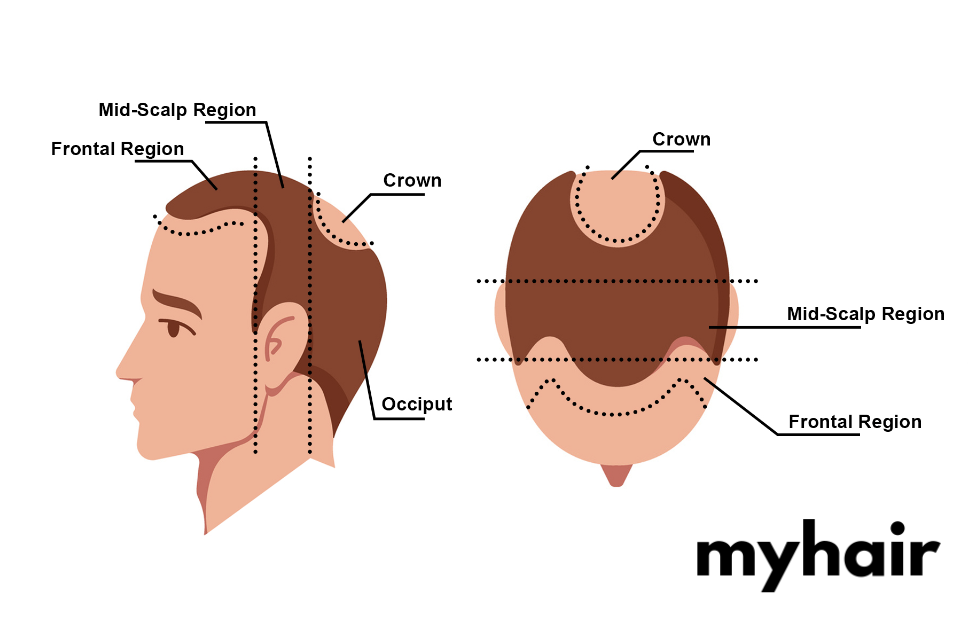In many hair loss disorders, people’s hair starts falling out spontaneously. The trigger could be an illness, a physical response to a new medication, an autoimmune condition, or any number of other reasons.
But in androgenic alopecia, the most common cause of balding, hair loss is gradual. Often referred to as pattern baldness, this form of hair loss involves the gradual thinning of hair and shrinkage of hair follicles, which is known as hair miniaturization.
What is hair miniaturization?
Hair miniaturization is a phenomenon in which your hair follicles shrink, causing the long, dark terminal hairs they produce to become increasingly thinner, shorter, and weaker over time. As hair miniaturization progresses, even tiny, fragile terminal hairs stop being produced. Fine vellus hairs – like the peach fuzz that grows on your face and other parts of your body – begin to grow in their place.
What causes hair miniaturization?
Hair miniaturization is thought to be caused by three main factors: hormones, inflammation, and disruptions to the hair growth cycle. Out of these three, the main factor is the hormonal one – specifically, the hormone dihydrotestosterone (DHT).
DHT is thought to be one of the main culprits behind androgenic alopecia. Hair follicles affected by miniaturization are sensitized to DHT. If this androgen binds to them, it triggers the miniaturization process. As more and more receptors bind to DHT, the follicle becomes increasingly affected, producing smaller, weaker hairs.
But this isn’t the only issue occurring. According to the medical textbook Endotext, the hair growth cycle is disrupted, too, contributing to the miniaturization process.
Healthy hairs usually spend most of their time growing. This is known as the anagen phase. This growing phase lasts an average of 3 to 5 years.
The rest of the hair growth cycle occurs over about 4 months. The few weeks involve the catagen phase, where hairs transition from growth to rest. The remaining 3 or so months are used by the resting phase (also known as the telogen phase), which ends with the hair being shed from the follicle.
Androgenic alopecia changes the lengths of the hair growth cycle phases. The anagen phase of the hair growth cycle is reduced, partially contributing to the shorter hair lengths the hair follicles produce. And simultaneously, the length of the telogen phase is increased, delaying the follicle’s ability to produce a new hair strand.
And finally, during all this, the body’s immune system triggers an inflammatory response. Inflammation is specifically thought to affect the upper part of hair follicles, though inflammation surrounding the lower regions of follicles has also been reported. While an inflammatory response in androgenic alopecia is definite, it’s not completely certain how large a role it plays in miniaturization and balding.
Hair miniaturization: How to tell it’s happening
Since hair miniaturization is a phenomenon specific to androgenic alopecia, it tends to occur in set areas. According to the textbook Endotext and a study in the Journal of Cutaneous and Aesthetic Surgery, hair miniaturization specifically affects three parts of the head: the temples, vertex (also known as the crown), and mid-frontal sections of the scalp.
Men with androgenic alopecia are likely to first see changes to their hairline, followed by hair loss at the temples and crown. Eventually, later-stage hair loss affects the mid-frontal scalp. If you suspect you’re experiencing early-stage androgenic alopecia, keep an eye out for signs of hair miniaturization.
Hair miniaturization symptoms tend to include:
- Identifying a large amount of shorter than average hairs. These may look like thin, fine baby hairs around the hairline, temples, and crown.
- Feeling like your forehead is getting larger or seeing other hairline changes, particularly around the temples.
- Feeling like hair is weaker and falls out more easily when brushed or pulled.
- Noticing that your hair’s volume has decreased.
- Noticing that you can see more of your scalp than you used to, especially around where you tend to part your hair.
The human scalp contains thousands of hair follicles, each of which has two to five terminal hairs. Miniaturization doesn’t affect all of these hairs at the same time. Instead, they’re affected one at a time, leading to a reduction in the number of terminal hairs each follicle can produce. This is what gives the appearance of thinner hair and the feeling of reduced hair density, even when visible hair can still be seen growing from that part of the scalp.
Can hair loss be reversed?
Hair loss due to miniaturization can be reversed – but only if it’s caught early enough. Follicles that have been dormant for a while are unlikely to be able to produce hair again.
As you likely know, you can’t see these hair follicles – you can only see hair strands once they emerge from your skin. According to Endotext, the miniaturization process causes hair follicles to produce such small, weak hair strands that they never even reach the skin’s surface. But even at this stage, those hair follicles can potentially still be saved.
Hair follicles obtain nutrients from vessels beneath the skin, in it’s dermal vascular plexus. These vessels also support waste elimination and hair strand production. As the miniaturization process goes on, these vessels shrink, restricting blood flow to follicles.
Eventually, a follicle’s vessels constrict and detach completely. At this point, it’s unlikely to be able to produce hair strands again. It’s at this stage that hair loss is likely to be irreversible, leaving individuals with only one hair loss treatment option: a hair transplant.
Why do hair transplants work?
Hair transplants move hair follicles from another part of the head – like the back of the scalp – to the area affected by hair loss. But hair used in transplants actually doesn’t even need to come from your head. Beard, chest, and other body hair can be transplanted onto the scalp.
But you’re probably wondering: Won’t I just lose that hair, too? And that’s the best part. Transplanted hair follicles aren’t affected by hair loss in the same way.
DHT shrinks hair follicles found in certain parts of the head. But the location of the head has nothing to do with the miniaturization process. It’s actually the specific follicles residing in those regions that are sensitized.
And strangely, while DHT triggers hair loss at the temples, crown, and top of the head, it has the complete opposite effect on other parts of the body. Androgens are known to stimulate hair growth around your face, armpits, and pubic areas.
Even though extensive hair loss can require several costly hair transplantation surgeries, you can at least feel secure knowing that those transplanted hairs won’t be falling out anytime soon. The only hairs you’d permanently lose following a hair transplant are those that end up being damaged during the procedure or are unable to adapt to their newly transplanted area.
Other hair loss treatments
According to StatPearls Publishing and Endotext, there are three FDA-approved solutions for androgenetic alopecia: minoxidil, finasteride, and laser hair therapy. All of these are thought to work best on people with mild-to-moderate hair loss symptoms.
Minoxidil was the first treatment to be FDA-approved for pattern hair loss. This medication was initially developed as a blood pressure reducer. In its topical form for hair loss, it works in the same way: widening blood vessels, allowing more blood, oxygen, and nutrients to reach the scalp’s hair follicles. It’s also thought to help regulate the hair growth cycle. This topical drug is sold as a liquid and foam in concentrations of 2 and 5 percent. The 5 percent solution is thought to be the most effective for men.
Finasteride was the second treatment to be FDA-approved for androgenic alopecia and remains the only oral drug approved as a hair loss treatment. This medication works as a DHT blocker, preventing the hormonal component of the miniaturization process. It’s meant to be taken as a single 1-milligram dose once a day.
Low-level laser therapy is the most recent addition to the FDA’s list of treatments for pattern hair loss. This light therapy has a biostimulatory effect on the scalp and can stimulate hair growth. Like minoxidil, it’s thought to help improve blood flow to the scalp and follicles.
Hair miniaturization and its reversal
Hair miniaturization refers to the gradual shrinking of hair follicles that occurs in people with pattern hair loss. Hair follicles affected by miniaturization get smaller, forming thinner and weaker hairs each time they produce hair strands. Eventually, the process forces follicles to detach from their nutrient source, preventing them from ever producing hairs again.
Hair miniaturization isn’t an instantaneous occurrence, so your hair follicles won’t shrink overnight. In fact, the whole process generally takes years. But eventually, without treatment, follicles shrink to the point where they no longer produce terminal hairs at all, resulting in balding. When hair loss reaches this stage, the only treatment option available is a hair transplant.
If you’d rather not undergo surgery, try one of the FDA-approved treatment options for pattern hair loss. Minoxidil can help stop the miniaturization process by widening blood vessels, allowing more blood, oxygen, and nutrients to reach your hair follicles, and regulating the hair growth cycle. Finasteride targets the hormonal side of hair miniaturization, blocking DHT so that hair follicles can continue to produce strong, healthy hairs.
The newest FDA-approved hair loss treatment, low-level laser therapy, uses light to help boost hair growth. This treatment works through a direct biostimulatory effect on the hair follicle and surrounding tissue.





